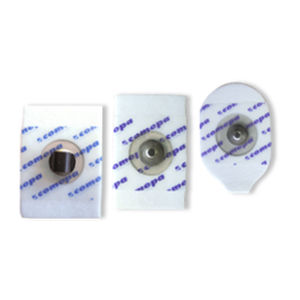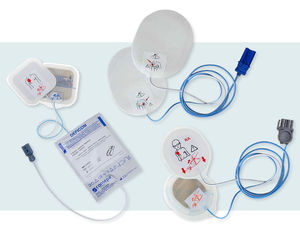

- Products
- Catalogs
- News & Trends
- Exhibitions
Pad defibrillation electrode pediatric
Add to favorites
Compare this product
Characteristics
- Type
- pad
- Applications
- pediatric
Description
The BBCOM range offers a wide choice of sizes, shapes, sensor types and connectors to best meet user expectations
The hypoallergenic conductive hydrogel common to all BBCOM electrodes is a high-tech COMEPA Industries development. It ensures high quality traceability m all environmenls
The design of BBCOM electrodes, which is the result of many years of experience, gives users safety, reliability and flexibility
Performance
The different forms available allow a wide choice adapted to each patient: very premature, premature, newborn, child
High-reliability components offer great safety in all types of environment.
The design of the BBCOM electrodes extends the life of the products safely.
Safety
Moulded connectors are easily identi- fiable by international colour codes.
The 1.5mm DIN42802 and 4.0mm soc- kets are compatible with all connecting cables.
All electrodes are available in lengths of 35cm or 50cm.
Biocompatible The high conductivity gel provides excellent conductivity. It is biocompatible with all types of skin.
Its hydroabsorbent power provides low impedance and prolongs its life, leaving no adhesive residue on the patient when removing the electrode.
On a premature patient, a daily change of the electrodes is recommended.
Related Searches
- Cannula
- Curved cannula
- PVC medical mask
- Endotracheal tube
- Silicone medical mask
- Laryngoscope blade
- Metal laryngoscope blade
- Intubation cannula
- Supraglottic airway device
- Oral endotracheal tube
- Macintosh laryngoscope blade
- Silicone laryngeal mask
- Disposable laryngoscope blade
- Laryngoscope handle
- Oral and nasal endotracheal tube
- Stainless steel laryngoscope blade
- Miller laryngoscope blade
- PVC laryngeal mask
- Guedel cannula
- LED laryngoscope handle
*Prices are pre-tax. They exclude delivery charges and customs duties and do not include additional charges for installation or activation options. Prices are indicative only and may vary by country, with changes to the cost of raw materials and exchange rates.


